As the sun rises over the bustling city of New York, the streets are filled with the sounds of honking horns, sirens, and the hustle and bustle of city life.
But amidst all the chaos, there is a world of beauty and wonder that often goes unnoticed.
From the parks and green spaces to the rooftops and balconies, New York is home to a diverse range of bird species that are waiting to be discovered.
Whether you’re an avid birdwatcher or simply enjoy the sights and sounds of nature, join us as we take a closer look at the 13 most common birds in New York and discover the fascinating stories behind these feathered residents of the Big Apple.
| Image | Bird | Features | Price |
|---|---|---|---|
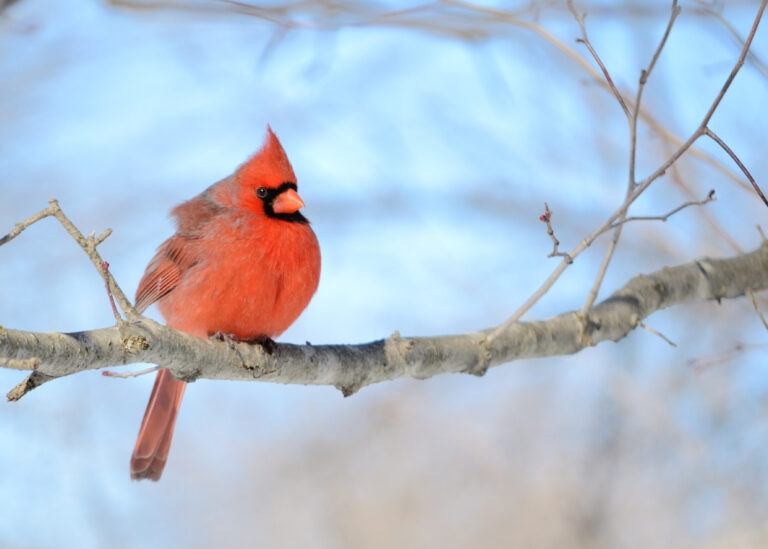 |
| 9.7 | Check Price |
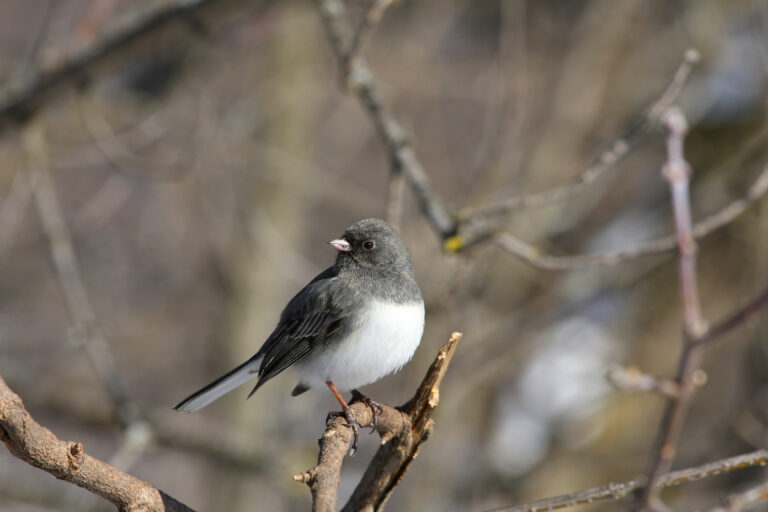 |
| 9.5 | Check Price |
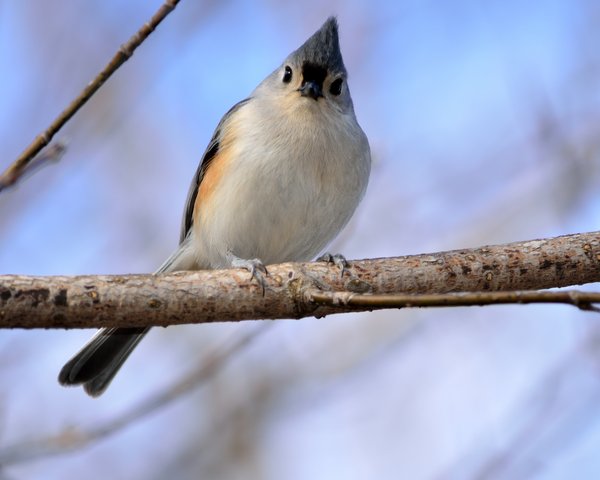 |
| 9.1 | Check Price |
 |
| 8.8 | Check Price |
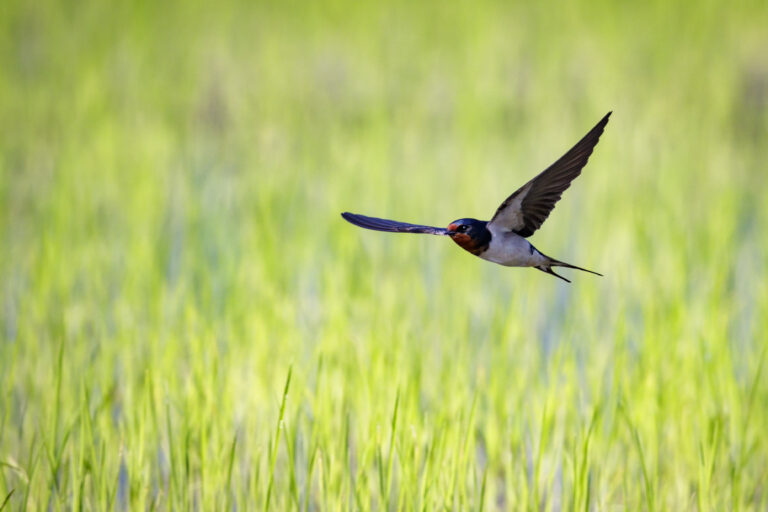 |
| 8.6 | Check Price |
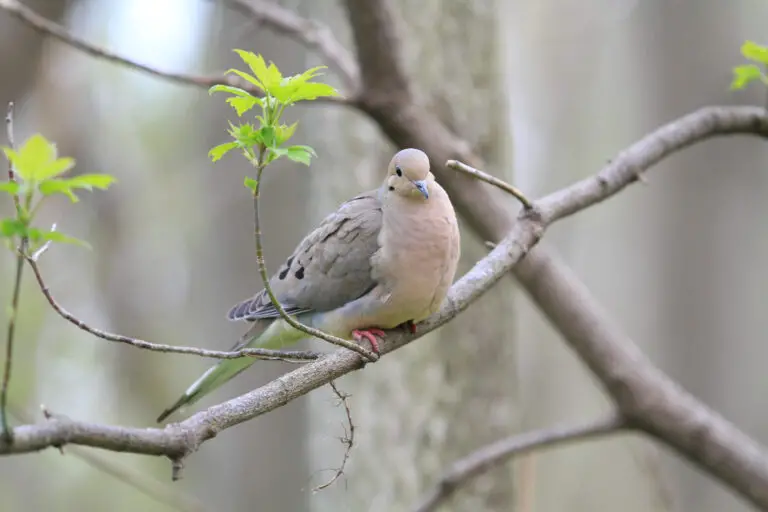 |
| 8.2 | Check Price |
 |
| 8 | Check Price |
 |
| 7.7 | Check Price |
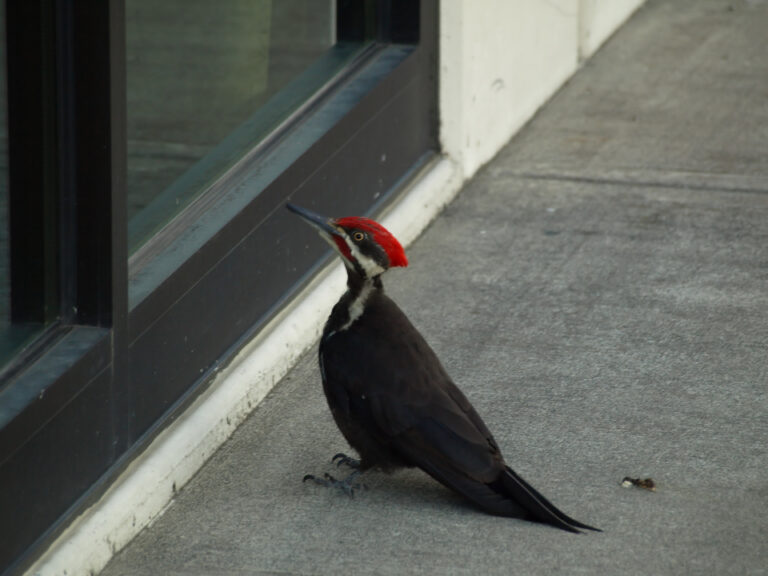 |
| 7.4 | Check Price |
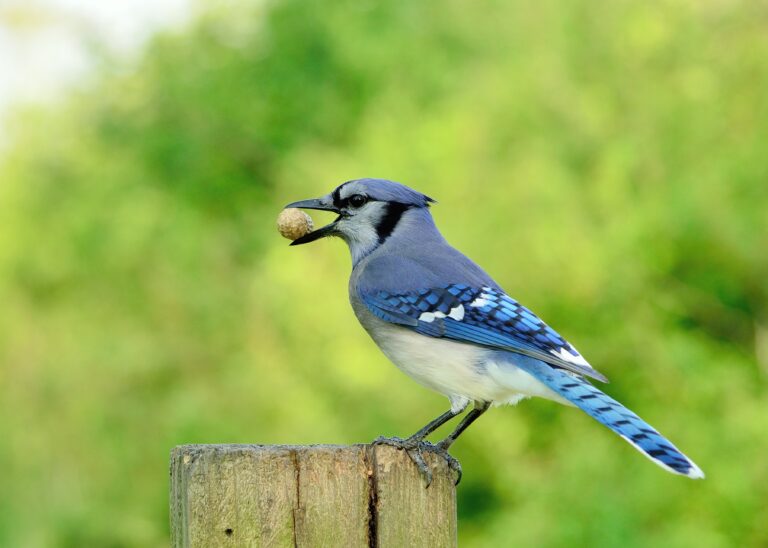 |
| 7.2 | Check Price |
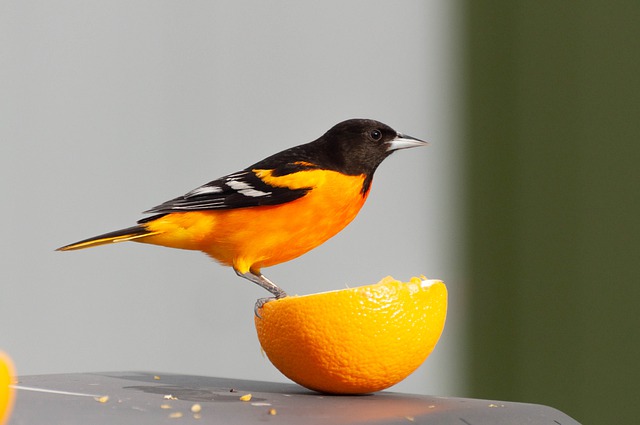 |
| 9.5 | Check Price |
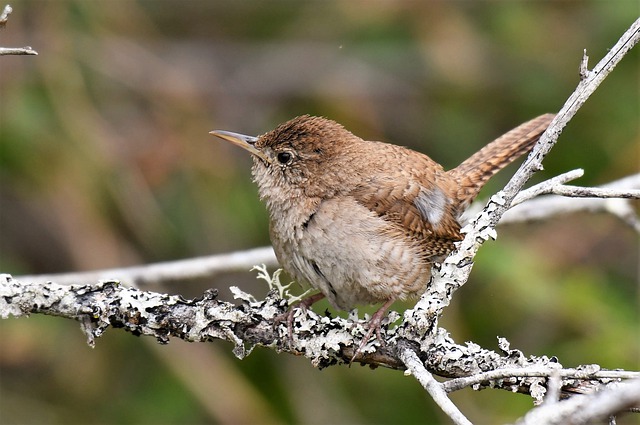 |
| 9.5 | Check Price |
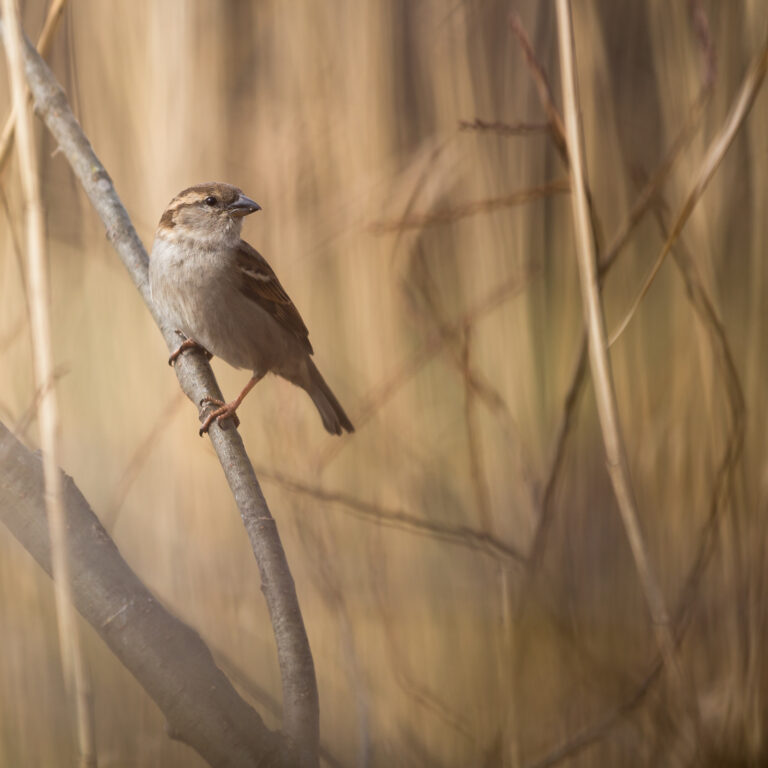 |
| 9.5 | Check Price |
New York is home to over 200 different bird species, all of which are waiting to be discovered if you know where to look and when to look.
After reading this article, you will be able to recognize them, know where to seek them, and what items to put in the feeder to match their diets as nearly as possible.
If you don’t have the time to read the whole article, check out this video for a quick understanding.
Most Common Birds in New York
1. Northern Cardinal

Northern Cardinals (Cardinalis cardinalis) are stunning birds, and seeing one has encouraged many people to take up birding.
Males and females are easily distinguished, with males having entirely red bodies, lengthy wingspans and tails, and a richer red coloring on their cheeks.
There will also be a distinctive black mask that covers the eyes and continues down to triangulate beneath the enormous conical orange bill.
When males molt, they may show a little grey, but generally, watch for that unmistakable red, which is difficult to miss.
Cardinals have a light brown coloring with traces of red throughout the plumage that is no less beautiful.
The length of these birds ranges from 8.3 to 9.1 inches, with wingspans ranging from 9.8 to 12.2 inches.
Cardinals prefer wide spaces with some thick cover, so seek them in places with trees and shrubs or bramble nearby.
When they’re not in the woods, these birds aren’t afraid of humans and may be found all around the city.
Look for them on walls including in your own yard, where they could be investigating the feeder.
Oils of Safflower with Black Sunflower seeds are a favorite food of this bird, as are peanuts and crushed cherries.
Below are the characteristics of the Northern Cardinal,
| Scientific Name | Cardinalis cardinalis |
| Family Name | Cardinalidae |
| Length | 8.3 – 9.3 inches (21 – 23.5 cm) |
| Weight | 1.5 – 1.8 ounces (42 – 50 g) |
| Wingspan | 9.8 – 12.2 inches (25 – 31 cm) |
| Habitat | Woodlands, gardens, and shrublands |
| Food | Seeds, fruits, insects, and occasionally small lizards or snakes |
2. Dark-eyed Junco

As there are over 16 regional variants of the Dark-eyed Junco (Junco hyemalis), it was chosen to go with the most common coloring.
Juncos have dark grey or brown backs, medium-length grey wings, and long grey tails with white undersides.
This bird has a white rump and a dark brown or grey skirt that starts at the underbelly and gets bigger as the color approaches the breast.
When the bird is at rest, the white will be primarily in the middle or on the breast, with the grey and brown surrounding strongly.
This gives the appearance of the bottom 23 being white and the top 23 being dark brown or grey.
This bird has a strong, conical pink beak, and its face will be brown or grey in hue to match the rest of its upper body.
These birds are between 5.5 and 6.3 inches long, with wingspans ranging from 7.1 to 9.8 inches.
In the summer, these birds prefer coniferous or mixed coniferous forests, while in the winter, they have the largest range.
They then become regulars in the parks and backyards of the community.
You could get a closer look at the gorgeous Dark-eyed Junco if you leave a little bit out for them to demonstrate that they are welcome.
These birds prefer Black Oil Sunflower seeds, broken corn, and White Proso millet, so if you want to attract their attention, leave one or these entire out.
Below are the characteristics of the Dark-eyed Junco,
| Scientific Name | Junco hyemalis |
| Family Name | Passerellidae |
| Length | 5.5 – 6.3 inches (14 – 16 cm) |
| Weight | 0.6 – 1.0 ounces (18 – 28 g) |
| Wingspan | 7.5 – 9.8 inches (19 – 25 cm) |
| Habitat | Woodlands, forests, and brushy areas |
| Food | Seeds, insects, and occasionally berries |
3. Tufted Titmouse

To match its long, gray tails, the Tufted Titmouse (Baeolophus bicolor) has a velvety grey back and medium-length blue-gray wings.
Their breasts and underside are white with an orange-yellow wash underneath the wings, and their faces are primarily white going up to the cheek level and around the eyes.
The rear and top of the bird’s head, on the other hand, are gray-blue, and it has a charming tiny crest.
A big black patch will also be seen atop a short, stocky black bill.
The length of these birds ranges from 5.5 to 6.3 inches, with wingspans of 7.9 to 10.2 inches.
Tufted Titmice prefer deciduous and evergreen woodlands, although they can be found in parks, residential gardens, orchards, and backyards as well.
These birds enjoy sunflower seeds as well as crunchy peanut butter.
Try one or more of them as a starting point and expand from there since these tiny fellas enjoy a wide range of meals.
Below are the characteristics of the Tufted Titmouse,
| Scientific Name | Baeolophus bicolor |
| Family Name | Paridae |
| Length | 5.5 – 6.7 inches (14 – 17 cm) |
| Weight | 0.6 – 0.7 ounces (18 – 20 g) |
| Wingspan | 7.9 – 9.1 inches (20 – 23 cm) |
| Habitat | Deciduous forests and woodlands |
| Food | Insects, seeds, nuts, and berries |
4. Black-capped Chickadee
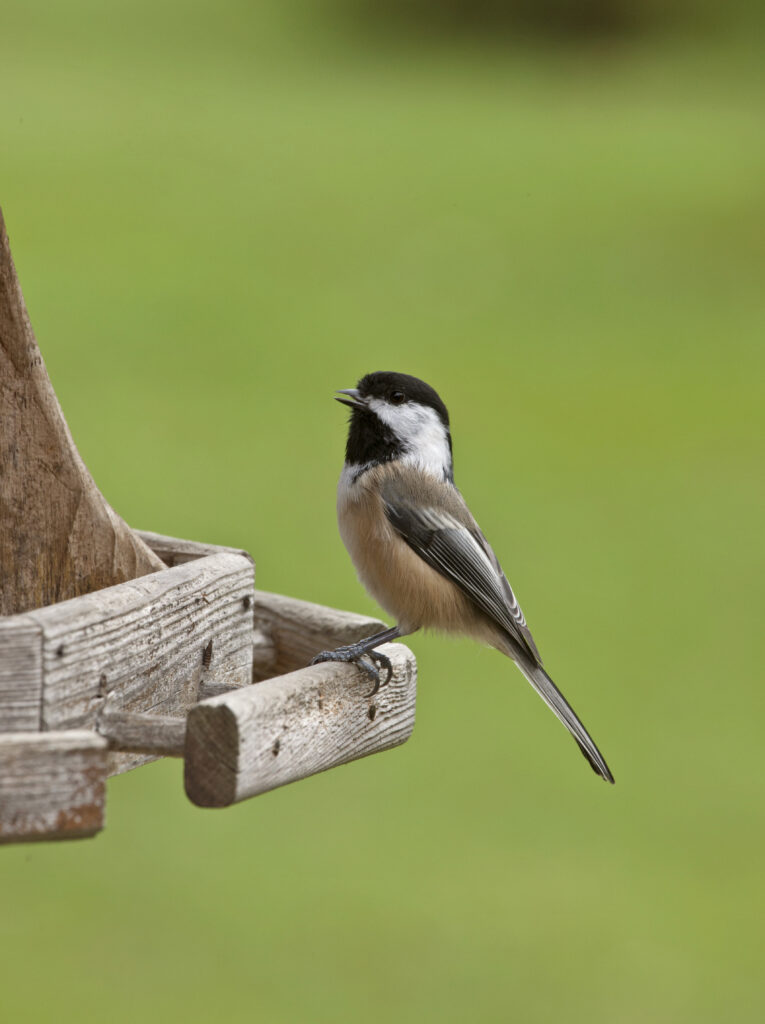
The backs of Black-capped Chickadees (Poecile atricapillus) are velvety grey, with medium-length grey wings with white outlining and long grey tails with white borders.
Their faces are white in the center, with a black bib underneath the bird’s bill and a large black cap above that finishes just below the mid-eye level.
The rear bills of these birds are small and conical. From head to tail, these tiny beauties are 4.7–5.9 inches long, with wingspans ranging from 6.3 to 8.3 inches.
Chickadees just require trees and some shelter, such as brush, thorns, or shrubs.
They also enjoy the water, so you may see them around ponds or in marshes where there is some cover, and they frequently visit parks and friendly backyards with well-stocked feeders.
The Black-capped Chickadee’s favorite meals are chunky peanut butter and sunflower seeds which can entice them and keep coming back for more.
Below are the characteristics of the Black-capped Chickadee,
| Scientific Name | Poecile atricapillus |
| Family Name | Paridae |
| Length | 4.5 – 5.1 inches (11.5 – 13 cm) |
| Weight | 0.3 – 0.5 ounces (9 – 14 g) |
| Wingspan | 6.3 – 8.3 inches (16 – 21 cm |
| Habitat | Woodlands, forests, and suburban areas |
| Food | Insects, seeds, nuts, and berries |
5. Barn Swallow
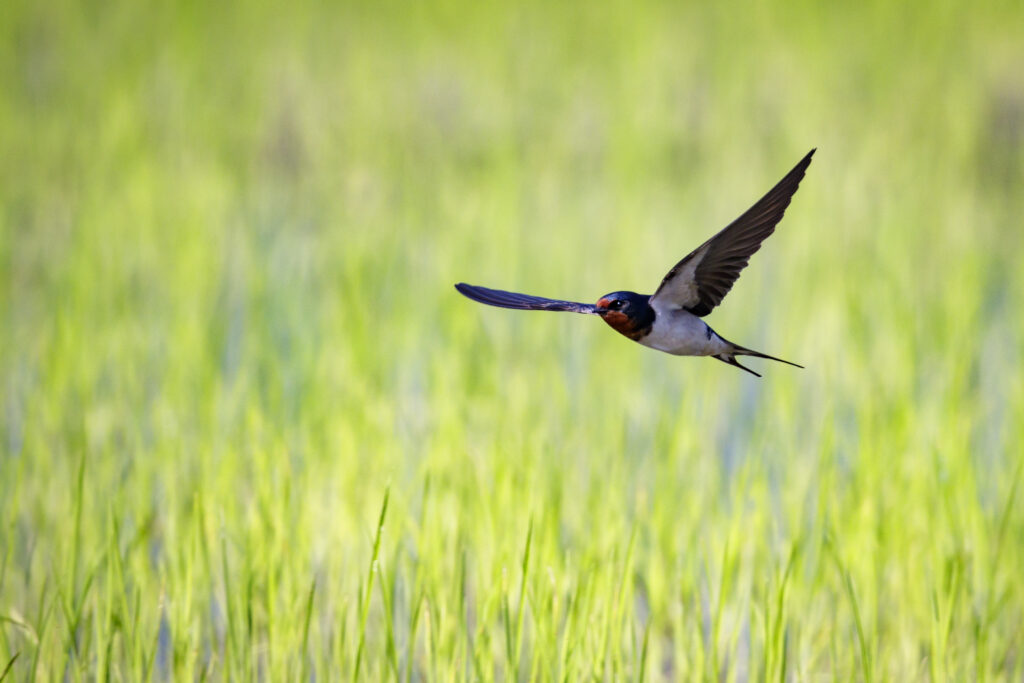
Barn Swallows (Hirundo rustica) have dark blue backs and lengthy, deep blue, and occasionally grey wigs.
They have long, forked blue tails, and you could detect some white dots under the tail as the bird is flying.
The breast and underside of this bird are orange with some white behind the wings and a little over each shoulder, and the blue from the back appears as a line diagonally from each shoulder to the center of the breast, but it stops short.
It appears like the wings are ‘attached’ to these lines.
The bird’s face is orange till approximately cheek level, with an orange stripe running up the middle of the face to just above the beak, while the top half of the face is a deep blue.
The length of these birds ranges from 5.9 to 7.5 inches, with wingspans of 11.4 to 12.6 inches.
These birds prefer wide spaces and can be seen in fields, parks, and even along the shore or in ponds.
They aren’t afraid of human settlements, so look for them near your work shed, nesting in bridges, or inspecting your garden feeder.
In rare instances, you may catch those eating suet, but berries are typically your best chance.
However, there’s still a chance this won’t work, so use some crushed eggshells to hedge your bets.
Barn Swallows will occasionally ingest eggshell fragments if you leave them available, which are said to assist the bird’s digestion.
Below are the characteristics of the Barn Swallow,
| Scientific Name | Hirundo rustica |
| Family Name | Hirundinidae |
| Length | 6.7 – 7.5 inches (17 – 19 cm) |
| Weight | 0.6 – 0.7 ounces (16 – 20 g) |
| Wingspan | 12.6 – 13.4 inches (32 – 34 cm) |
| Habitat | Open fields, meadows, and wetlands |
| Food | Flying insects, such as flies, mosquitoes, and beetles |
6. Mourning Dove
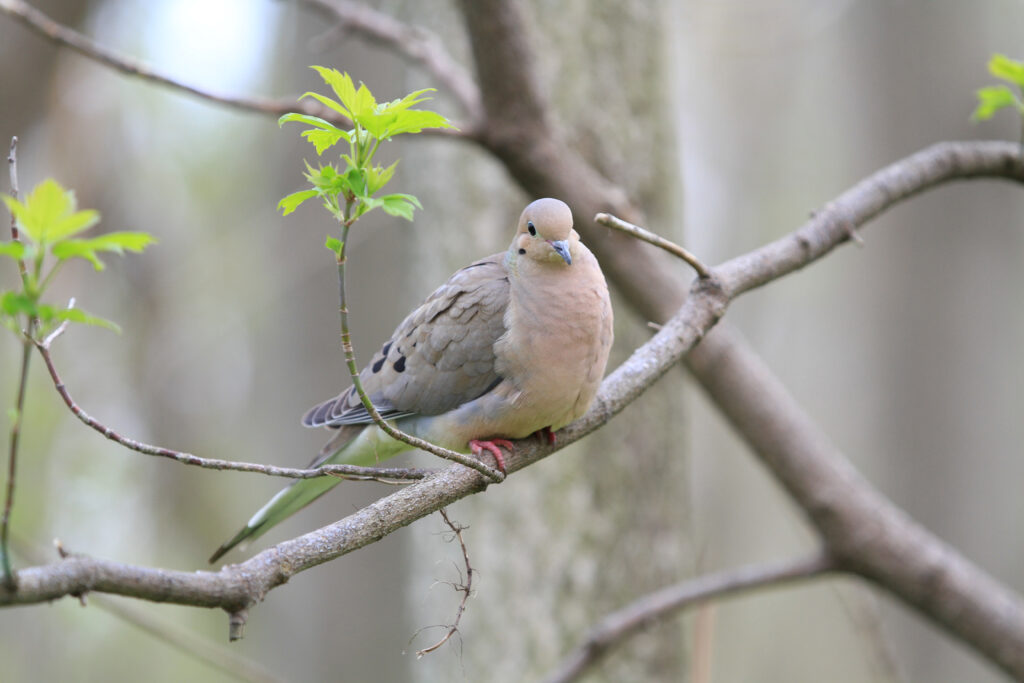
Mourning Doves (Zenaida macroura) have grey or brown backs, big gray wings with a strong tan coloring and prominent black spotting in the center, and grey or brown wings.
Their tails are long and grey, and their breast and underside are white with a tan saturation.
This Dove has the most vivid tan color on its face and a medium-long straight black bill.
These birds are roughly the size of Robins, having wingspans of 17.7 inches and a length of 9.1 – 13.4 inches from tip to tail.
Look for these birds in parks and unkempt fields, or just about everywhere near the town, rather than in the woods.
These birds aren’t very timid as long as there’s some cover around, and they’re frequently observed on the sidewalk or peering over a neighboring fence.
When it comes to feeder food, crushed corn, White Proso cereals, or a basic combination of grain and oats can turn Mourning Doves into Cheerful Doves.
Below are the characteristics of the Mourning Dove,
| Scientific Name | Zenaida macroura |
| Family Name | Columbidae |
| Length | 10.5 – 13 inches (27 – 33 cm) |
| Weight | 4.0 – 6.0 ounces (112 – 170 g) |
| Wingspan | 17 – 19 inches (43 – 48 cm) |
| Habitat | Open fields, woodlands, and suburban areas |
| Food | Seeds and grains, as well as insects and snails |
7. Cedar Waxwing

Cedar Waxwings (Bombycilla cedrorum) have an interesting color scheme.
The velvety brown of their upper back and shoulder parts of the wings fades to a sleek grey as it travels down the back.
Long wings are predominantly grey, going down with the exception of blackening at the tips and a display of vertical waxy-red lines near the middle of the wing.
The tails are short and yellow-tipped with a black coating over the yellow to differentiate it from the grey of the remainder of the tail.
This bird’s rump is white, while the breast and underside are a combination of white and light yellow, with a brown beard-like bib draped magnificently over the front and center of the breast.
This bird has a velvety-soft brown face with a black mask that extends past the eyes and curls up to reach the end of the beautiful brown crest.
The mask is accented by little white lines that appear above and below it, and the bird has a short, thick black beak that is straight with a tiny bend in the top section.
The length of these birds ranges from 5.5 to 6.7 inches, with wingspans ranging from 8.7 to 11.8 inches.
These birds enjoy spending time in the woods, but they also visit parks and orchards.
They will cheerfully visit a feeder if you have placed something tasty out for them.
Cedar Waxwings consume insects mostly, but they also have a sweet appetite and can be enticed by fruits and berries.
If you leave out the orange halves and blueberries, the results could surprise you.
Below are the characteristics of the Cedar Waxwing,
| Scientific Name | Bombycilla cedrorum |
| Family Name | Bombycillidae |
| Length | 6.5 – 7.5 inches (16 – 19 cm) |
| Weight | 1.0 – 1.5 ounces (30 – 42 g) |
| Wingspan | 11 – 12 inches (28 – 30 cm) |
| Habitat | Woodlands, orchards, and suburban areas |
| Food | Fruit, insects, and occasionally sap |
8. White-breasted Nuthatch

The White-breasted Nuthatch (Sitta carolinensis) has a gorgeous gray body and moderate wings with black accents and a tiny white wing bar on each wing.
The bird has short perky grey and black tips with white undersides, as well as a snowy-white breast and abdomen.
A prominent rust-red mark on the underside may be seen if you look closely, although it can be difficult to notice if the bird is jumping around.
The white from the breast and belly flows up into the face, taking up most of it, with the exception of a little black line from the rear of the eye that continues diagonally up and a thin black cap that runs from the bill to the shoulder.
The beak of this bird is long and straight, generally black on top and white on the bottom.
These birds have wingspans of 7.9 to 10.6 inches and a length of 5.1 to 5.5 inches from head to tail.
These birds may be found in both the deep woods and the forest’s edge, favoring deciduous areas and trees like Oak, Hickory, and Maple. Coniferous forests are their second choice, and they will go out to parks and backyards for some foraging, especially in the winter.
Nuthatches are simple to satisfy. You’ll only need shelled peanuts and suet to get started.
Below are the characteristics of the White-breasted Nuthatch,
| Scientific Name | Sitta carolinensis |
| Family Name | Sittidae |
| Length | 5.5 – 6.3 inches (14 – 16 cm) |
| Weight | 0.6 – 1.1 ounces (18 – 32 g) |
| Wingspan | 8.7 – 10.6 inches (22 – 27 cm) |
| Habitat | Deciduous and mixed forests |
| Food | Insects, seeds, nuts, and suet |
9. Pileated Woodpecker

Pileated Woodpeckers (Dryocopus pileatus) have a brutally beautiful appearance with black backs and long black wings with white on the undersides from the middle to just before the black tips.
When the bird is in flight or merely flapping its wings to show off, this white produces a crescent shape that looks wonderful.
Long thin black tails with a smidgeon of white on the undersides, as well as a black breast with a black and white speckled underbelly, distinguish them.
Woodpeckers possess long necks that are dark in front and rear but white on the sides, as well as white cheeks with a red stripe running from the beak to just below the back of the head and a black eye line with a stunning crimson triangular crest.
The bird almost appears to have a large red Mohawk.
These are old Woodpeckers, with wingspans of 26 to 29.5 inches and lengths of 15.8 – 19.3 inches from head to tail.
These birds like mature forests of virtually any type and frequently visit regions with downed, dead trees; however, they are not afraid to venture into parks or backyards if they get hungry.
They enjoy suet and, if you have any, will eat peanuts on occasion.
Try a little crispy peanut butter if your neighbor has already put out peanuts; it could just lead to a competitive advantage whenever the bird is deciding where to eat.
Below are the characteristics of the Pileated Woodpecker,
| Scientific Name | Dryocopus pileatus |
| Family Name | Picidae |
| Length | 16-19 inches (40-49 cm) |
| Weight | 8-14 ounces (225-400 g) |
| Wingspan | 26-30 inches (66-76 cm) |
| Habitat | Mature deciduous or mixed forests |
| Food | Insects, fruits, nuts, and seeds |
10. Blue Jay
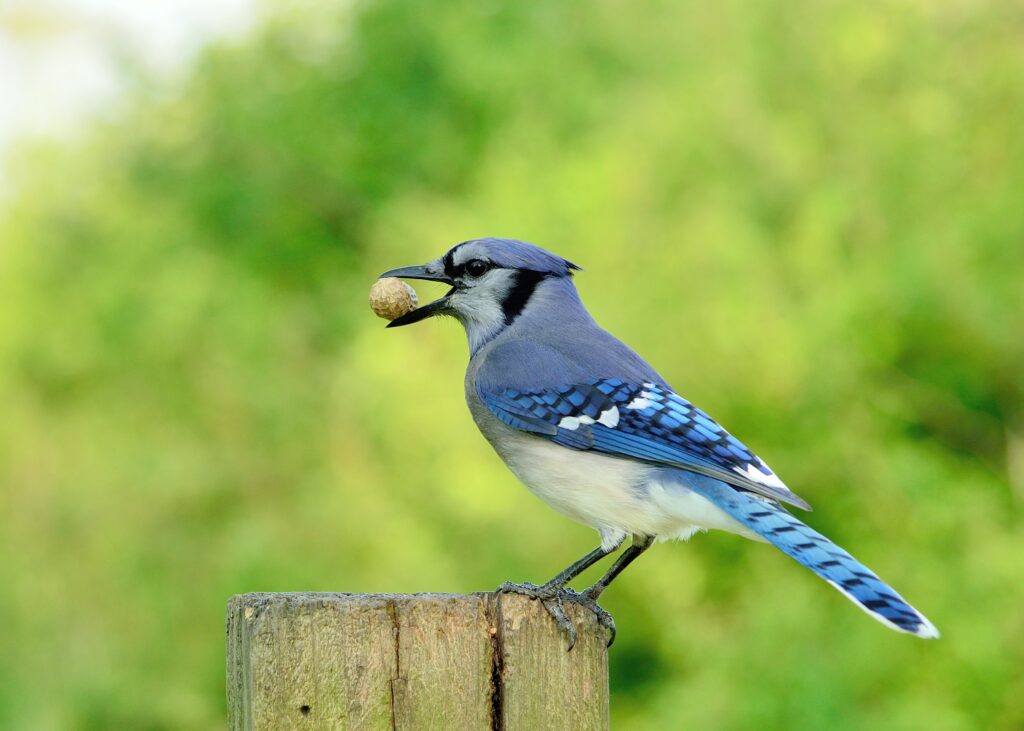
Blue Jays (Cyanocitta cristata) are magnificent birds. Light sapphire-blue backs and lengthy wings with blue scale patterns defined in black, huge white dots outlined in black toward the lower end, and a noticeable wing bar on each wing.
Their tails are white on the undersides with a symmetrical pattern of light blue edged in darker blue that runs the length of their long, slender body.
A black line appears from beneath the tall magnificent blue crest atop the bird’s head, disrupting the dazzling paper-white on the bird’s breast and underbelly.
This line continues around the base of the throat to the other side, returning to a white coloring that covers the majority of Jay’s face.
This bird also has a long, straight black beak and a distinctive thin black mask that is somewhat disorganized.
These birds range in size from 0.8 to 11.8 inches in length, with wingspans ranging from 13.4 to 16.9 inches.
These birds enjoy the woodland edge, especially if there are oak trees close with delicious acorns to pound.
When it comes to the city, however, blue jays are not bashful birds, and it is not uncommon to find them perched on phone wires or fences, looking for their next meal.
Peanuts and suet cakes are simple favorites that will catch and hold a Blue Jay’s attention.
Below are the characteristics of the Blue Jay,
| Scientific Name | Cyanocitta cristata |
| Family Name | Corvidae |
| Length | 9-12 inches (23-30 cm) |
| Weight | 2.5-3.5 ounces (70-100 g) |
| Wingspan | 13-17 inches (33-43 cm) |
| Habitat | Deciduous and mixed forests, parks, and suburban areas |
| Food | Seeds, nuts, fruits, insects, small animals (e.g. frogs, mice), and eggs |
11. Baltimore Oriole

The Baltimore Orioles (Icterus galbula) have a beautiful outfit.
Male Orioles have a fiery orange shoulder patch and long black wings with a distinctive white bar and white accents.
These birds have a bright fiery-orange breast and underbelly that reddens as it approaches the base of the neck, as well as black tails with yellow-orange borders and undersides.
This bird’s face is all black save for its medium-length stocky silver beak.
You will see that this dollar has a small curvature to it. Females and juveniles have a greyish tint on the head, which is less colorful, as well as two very visible wing bars.
The length of these birds ranges from 6.7 to 7.5 inches, with wingspans ranging from 9.1 to 11.8 inches.
These birds prefer open forests, particularly deciduous ones, so keep an eye out for them in meadows, copses, orchards, and parks.
They will also cheerfully visit a well-stocked backyard feeder, so leave some snacks out to entice the Baltimore Oriole into your yard.
It’s a sight to behold that will brighten your day! Suet, sliced apples, and orange marmalade are among this bird’s favorites.
Below are the characteristics of the Baltimore Oriole,
| Scientific Name | Icterus galbula |
| Family Name | Icteridae |
| Length | 7-8 inches (18-20 cm) |
| Weight | 1.4-1.8 ounces (40-50 g) |
| Wingspan | 9-12 inches (23-30 cm) |
| Habitat | Deciduous and mixed forests, parks, and suburban areas |
| Food | Insects, fruits, nectar, and jelly |
12. House Wren

House Wrens (Troglodytes aedon) have a smooth brown back and shoulders as well as brown and moderate white barring from the mid-wing to the tip of the short wings.
They have perky medium-length tails and a subdued version of the barring patterns found on the wings on the breast and underside, with more white on the breast and denser color on the underbelly.
It’s possible to see a white or whitish neck as well as white speckles from the base of the throat to beneath the bill and across the face.
A medium-length straight black bill with some moderate curves on the upper part of the beak and white spots that form a noticeable eyebrow line distinguishes this bird.
The wingspans of these little Wrens are around 5.9 inches from tip to tip, and they measure 4.3–5.1 inches in length.
These birds are most active in the summer, spending time in open habitats such as the forest edge or nearby fields.
They are most likely to be seen in your garden at this time of year, and they also enjoy foraging around farms.
In the winter, they prefer bushes and brambles, but if you’ve stocked your feeder in preparation for their arrival, you could get a visit.
Suet-hulled Black Oil and broken-up peanuts. Sunflower seeds are among the House Wren’s favorite foods, and they may be enticed to visit your feeder.
Below are the characteristics of the House Wren,
| Scientific Name | Troglodytes aedon |
| Family Name | Troglodytidae |
| Length | 4.3-5.1 inches (11-13 cm) |
| Weight | 0.3-0.4 ounces (9-12 g) |
| Wingspan | 6.7-7.9 inches (17-20 cm) |
| Habitat | Deciduous and mixed forests, grasslands, and residential areas |
| Food | Insects, spiders, and other small invertebrates |
13. House Sparrow
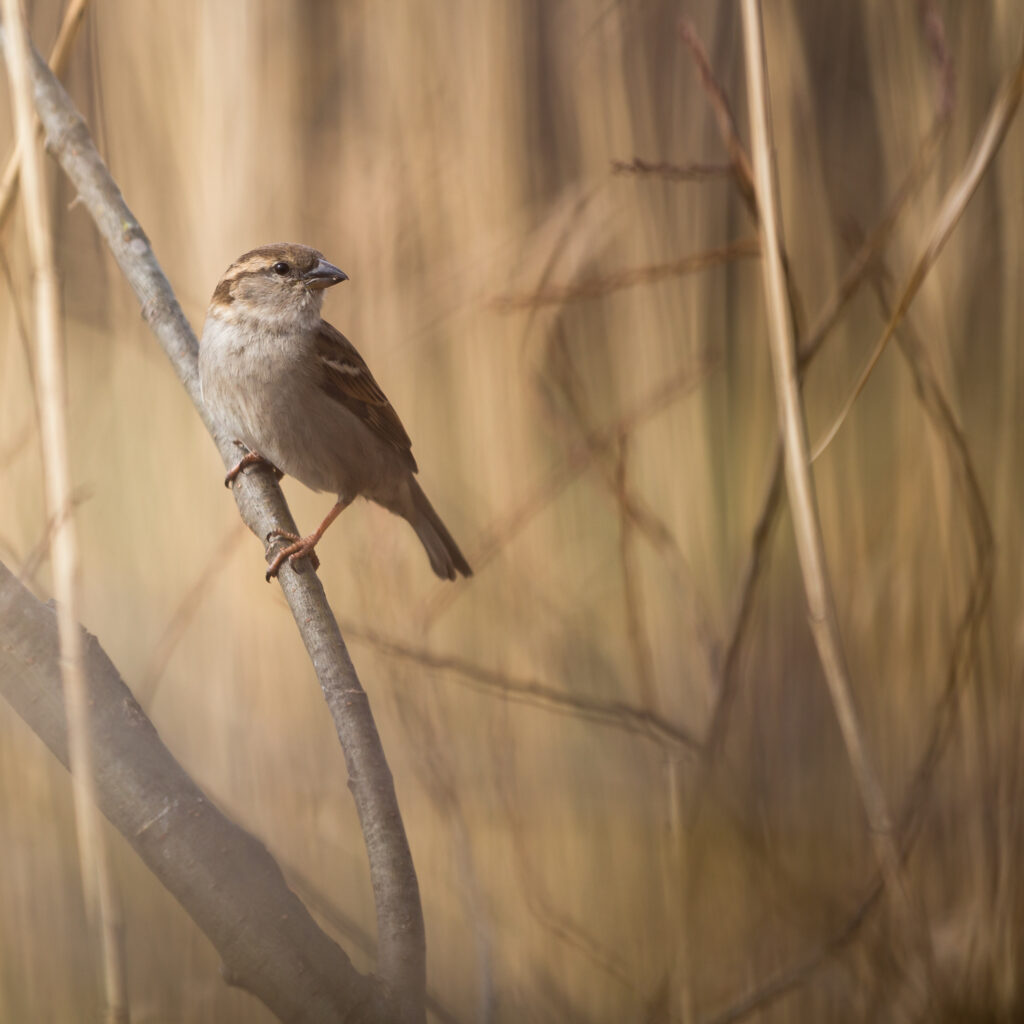
Male House Sparrows (Passer domesticus) have a black back and wing color with foxy-red or tan wing coloration.
These wings, like the tails, are medium in length, though the tail color is generally lighter, and a touch of grey can be seen.
This bird’s breast and underside are a silvery grey mixed with white that darkens as it approaches the underbelly and rump, and there is a concentration of black on the upper breast as if dripping down from the bird’s bib.
The cheek portion of the face is brilliant white, and it extends from the bib’s edge to the base of the throat, with a deep brown eye line that crosses across the eyes and curves into the frame of the cheeks.
The top of the bird’s head is velvet grey, frequently from the forehead down with a little amount of black above the short, stocky, dark beak.
On the upper portion of the bill, you’ll notice a curvature. Females, on the other hand, are typically a duller brown on top, with strong striping and a drab grey at the breast and underbelly.
Below are the characteristics of the House Sparrow,
| Scientific Name | Passer domesticus |
| Family Name | Passeridae |
| Length | 5.5-6.7 inches (14-17 cm) |
| Weight | 0.9-1.4 ounces (25-40 g) |
| Wingspan | 7.9-9.8 inches (20-25 cm) |
| Habitat | Urban and suburban areas, farms, and open fields |
| Food | Seeds, grains, and insects |
Conclusion
As we conclude our journey through the 13 most common birds in New York, it’s clear that these feathered creatures are more than just fleeting sights and sounds in our urban landscape.
From the melodious song of the American Robin to the striking plumage of the Northern Cardinal, each species brings its unique charm and personality to the city.
As we continue to coexist with these birds in our shared environment, let’s take a moment to appreciate their presence and the role they play in our ecosystem.
Whether it’s taking a stroll in the park or simply gazing out your window, keep an eye out for these avian friends and appreciate the beauty they bring to our lives.
FAQ
Where can I go birdwatching in New York City?
There are many places to go birdwatching in New York City, including Central Park, Prospect Park, Jamaica Bay Wildlife Refuge, and the Bronx Zoo. You can also find birds in many other parks and green spaces throughout the city.
What time of year is best for birdwatching in New York City?
The best time of year for birdwatching in New York City is during the spring and fall migration seasons, when many species pass through the area. However, you can find birds in the city year-round, and different species may be more active or visible during different seasons.
How can I attract birds to my backyard in New York City?
You can attract birds to your backyard in New York City by providing food, water, and shelter. This can include setting up bird feeders, bird baths, and nesting boxes. You can also plant native plants and trees that provide food and habitat for birds. Just be sure to keep your feeding areas clean to prevent the spread of disease.
How many bird species can be found in New York?
Over 200 bird species have been recorded in New York, including both resident and migratory birds.
What is the state bird of New York?
The state bird of New York is the Eastern Bluebird.
What are some of the best places for birdwatching in New York?
Some of the best places for birdwatching in New York include Central Park, Jamaica Bay Wildlife Refuge, Montezuma National Wildlife Refuge, and the Adirondack Mountains.
Last Updated on March 22, 2023 by Lily Aldrin
